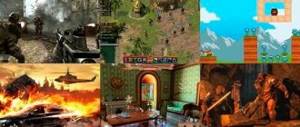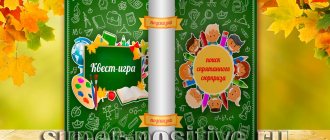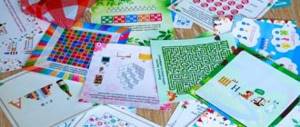Textbook
Players are divided into teams. Each team writes its own “textbook”. This is an ordinary notebook, on each sheet of which participants write one comic task. For example, raise your leg, close your eyes, wave your left hand, whistle, and so on. After which the teams exchange textbooks. They are given one or two minutes to prepare, and then all players must perform the actions in exactly the order in which they are indicated in the “textbook”. The winner is the team that has learned the theory better and completed the task correctly in practice.
Teacher to teacher
Teachers are asked questions from all subjects, whoever raises their hand first. He answers. For the correct answer - one point; naturally, the teacher who teaches the subject from which the question was asked does not answer. Whichever teacher can score more points wins. Examples of questions: Who wrote “Woe from Wit” (Griboyedov) What is the name of the first part of the physical education lesson? (organizing) How is power measured? (watt) What is the name of a chemical reaction that produces heat? (exothermic) Do prokaryotes have a nucleus? (no) Did Prince Igor fight with the Tatars or Pechenegs? (with the Pechenegs)
Master class “Use of modern quest gaming technology in educational work”
Municipal budgetary educational institution
“Lyceum No. 6 named after. I. Z. Shuklin, Gorno-Altaisk"
Master Class
“Use of modern gaming technology quest in educational work”
Sultanova
Natalya Valerievna,
class teacher of class 7A
Gorno-Altaisk, 2017
Master Class:
“The use of modern quest gaming technology in educational work.”
Purpose of the master class:
creating conditions conducive to the desire to innovatively transform one’s own professional experience.
Tasks:
1. Create an atmosphere of openness, goodwill, and co-creation in communication with colleagues.
2. Demonstrate skills that allow you to achieve a positive and qualitatively new result in the educational work of the class teacher.
3. Introduce the master class participants to quest technology.
4. Involve teachers in the active acquisition of new professional skills.
Participants:
teachers, class teachers.
Detailed description of the master class
- Preparatory and organizational stage.
Hello, dear colleagues and members of the jury. I would like to begin my work with the words of L. Borovikov “A teacher needs to constantly learn, learn from each other. And the best incentive for this should be the exchange of professional experience...”
Today I will conduct a master class on the topic “Using modern quest gaming technology in educational work.”
- Main part.
Quest technology is very popular among schoolchildren. A quest (from the Latin word quaero - searching, searching, conducting an investigation) is an adventure game in which participants must solve certain problems to achieve a specific goal. Quest technology was developed by University of San Diego professor Dodge Burney in 1995 as a way to organize search activities in the educational and educational processes.
Types of quests:
– linear (tasks are solved in a chain, one after another);
– assault (participants receive a task, tips for solving it, but choose the solution themselves);
– ring e
(teams of participants start from different points, and each follows its own path to the finish).
From the structure of the quest
:
1. Introduction. At this stage, the overall game goal is set.
2. Assignments . Solving emerging problems.
3. Conclusion . At this stage, the results are summed up and the winners are awarded.
I would like to present to your attention the quest “Kindness will save the world.”
The purpose of this quest is to create conditions for the formation of ideas about kindness as an important human quality.
– To work, I will need a team of 7 people. If you wish, please take a seat at the table.
So, stage I
quest -
Introduction.
Our common game goal: to collect a set of keys that will open the chest of Good.
We proceed to
stage II
-
“Tasks”.
For each successfully completed task you will receive one key.
1 task
“Code of Laws of Kindness”.
—
Imagine that kindness is a science that has its own laws.
Task: Pick up papyrus. Unfortunately, half of the phrases in the “laws of kindness” have disappeared over time, please restore them.
So, you have restored the “Code of Laws of Kindness”, present to us what you have done. (The “Code of Laws of Kindness” is read)
— I think you will always adhere to these laws of kindness in your life
.
After all, as V. Hugo said: “In the inner world of a person, kindness is the sun.”
You receive the first treasured key.
Task 2 “Libra”.
—What do you think is more on Earth: good or evil? (Answers) Scales will help us determine this. I will put stones on one pan of the scales as a symbol of people’s evil deeds. (I call it: people are jealous, they are rude, they betray, they fight.) To defeat evil, you must try to tip the scales with good. Assignment: Remember what good deeds you have done, and put stones on the scale with good. (Participants approach the scales one by one, talk about a good deed and place their pebble on the cup. Soon the scale of good outweighs the scale of evil.)
“So in life, as on our scales, the thicket of good outweighs the thicket of evil.”
Confucius said: “Try to be at least a little kinder - and you will see that you will not be able to commit a bad act.”
You get the second key, taking you two steps closer to the Good Chest .
Task 3 “All consonants”.
Task: guess the encrypted words, explain their meaning. (Vowels removed!)
Billion
Sstrdn
CBT
Vzmnpmsch
Tlrntnst
A.P. Chekhov said: “While you are young, strong and vigorous, do not get tired of doing good!”
You receive the third key.
Task 4 “It’s written on the forehead...”
I have an encyclopedia of Kindness, there are many beautiful and kind words in it. I took a few words from it for our assignment.
I will ask you to come to me and line up one after the other. I'm putting on glasses for you, they have signs with words on them. The one standing first takes a step forward and turns to his teammate, sees what is written on his forehead and explains in other words, avoiding similar words.
Words for explanation: volunteer, philanthropist, altruist, class teacher, thank you, philanthropist, friendship.
- You did a great job! I think such an encyclopedia of Good should be in every home. Also L.N. Tolstoy said: “The good that you do from the heart, you always do to yourself.”
You receive the fourth key.
Task 5 “Building a pyramid of Good.”
Next task:
build a pyramid of Good. To do this, you need to guess the person whose portrait is depicted on the cube. What these people have in common is that they are all philanthropists, philanthropists, and philanthropists.
So, the first cube...
- She is the best example for the modern world, her name has become a household name, she is the founder of the great, largest in modern society, the Order of Mercy. (Mother Teresa)
- This actress attracts public attention to the problems of children with cancer and hematological diseases. Provides social and psychological assistance to children with cancer, as well as finding funds for their treatment and rehabilitation, and is a co-founder of the Gift of Life charity foundation. (Chulpan Khamatova)
- This man was nominated for the Nobel Peace Prize in 2007; members of his brigade traveled to the combat zone. They provided assistance to victims of earthquakes and terrorist attacks. In 1996, media representatives said about him that he is the doctor of the world. (Leonid Roshal)
- The goal of the next heroine’s fund is to build up Russian cities with children’s playgrounds as much as possible. She is a mother herself and knows how important it is for her childhood to be interesting and in the fresh air. Her Naked Heart Foundation supports children with various developmental disabilities. (Natalya Vodyanova)
- The charitable foundation of this couple, “I Am,” assists in the adaptation into society of children with mental developmental disabilities, including Down Syndrome, providing them with the opportunity to live a full life and integrate into society. (Egor Beroev and Ksenia Alferova)
- The creator of the most beloved film magazine, the first issue of which appeared in 1974, since then more than 700 stories have been shown. He raised several generations of stars, everyone calls him “film dad”, every story in the magazine is educational, all examples from the school life of children. (Boris Grachevsky).
- The main areas of work of this person’s foundation: assistance in organizing the examination and treatment of children, purchasing medications, organizing rehabilitation programs, assisting Russian medical institutions that diagnose and treat brain diseases in children. (Konstantin Khabensky)
- This woman is the head of the Perspective Foundation. The proceeds from her charity show project “Two Stars” went towards the implementation of a competition of socially significant projects. (Olga Volosovtseva)
- So, we built the pyramid of Good.
The lives of these people serve as an example for us of self-sacrifice, empathy, and generosity. And our life can also become an example for others and become part of this pyramid of Good, the size of which has no limits. J. Joseph said: “ Good intentions are nothing if they are not translated into good deeds.”
You receive the fifth key.
Stage III
– Conclusion of the quest.
Now that you have the entire set of keys in your hands, you have the right to open the chest of Good. (Participants in the master class open a chest from which balloons fly out.)
Having done good, a person himself becomes better, cleaner, brighter. If we are attentive to any person, be it a random travel companion, a tramp, a person with disabilities, or a friend, this will be a manifestation of kindness. And kindness, as you know, will save the world. What it will be depends largely on us. After all, today a teacher is like a navigator who, having shown the path of good, can safely set his students on an independent voyage.
- Reflection of the master class.
– Dear colleagues, you have colored cards on your tables. Take them and complete the following phrases:
When I went to the master class, then………..
Participation in the master class allowed me……………….
- Thanks for communication. I am glad that I had the opportunity to speak to you.
8
The most famous teacher
Children answer the same questions about each of the teachers. About which teacher the children know the most information, that is, the teacher about whom the children give the most correct answers to questions is recognized as the most famous and receives a medal. Examples of questions: At what age did you start teaching? How many schools have you worked in? Favorite leisure activity? How many children? Favorite color? Favorite season? Favorite writer? What do you like more: tea or coffee? What will he choose: the sea or the mountains? And so on.
Lesson-quest. What is it and why you should try it
Many teachers are looking for new ways to engage children, get them interested in learning, and are trying new formats. Our blogger, author of Mousematics Zhenya Katz, talks about just one of these formats - a quest lesson that will help train learning skills, interaction, and even emotional intelligence.
Useful Mela newsletter twice a week: Tuesday and Friday
SUBSCRIBE
A quest lesson is an unusual form of conducting a lesson. Such a lesson helps the teacher not only test the students’ knowledge on a certain topic, but also see to what extent the students are able to complete their own tasks independently.
You can choose what topic to conduct a quest lesson on (you can call it a search lesson, a finder lesson, if you don’t like the word “quest”).
We do not pronounce the name “quest lesson” to children, but tell the plot of the story and invite them to join the game, the search. And we use the word “quest lesson” as a designation for this form of work.
In the quest format, we can conduct a test and test students’ knowledge on a topic that we have already “passed.”
What is special about this form of work?
The quest lesson takes a long time to prepare. Even if you make your own quests, it can be quite difficult to come up with them and it is not always easy to choose a quest that will suit your students’ level. If you guessed the difficulty level, the quest will go off with a bang. However, if you are, as they say, “under the age”, and the task turns out to be too difficult for many, then the children will find it difficult to complete the task, they will be distracted a lot, get tired quickly, and no one will enjoy the game.
It’s better to start getting acquainted with quests with obviously simple tasks, so that everyone can easily find 2-3 solutions. After this, it will be easier for you to offer students a more difficult quest another time.
Adults often think that tasks like “mittens” will be too simple for first-graders. However, practice shows that the quest lesson itself is a rather complex game, and each of the children must understand and remember very complex instructions.
Sometimes it is difficult for a teacher to clearly formulate a task and explain it to students
When you have printed everything out, prepared it, and hung it up, then the most difficult thing remains - starting the game. You need to explain the task to everyone at the same time, give everyone their sheet or card with the task, and ask again who has already understood what to do and is ready to go on their quest.
It is better to accompany the first two or three students at first, make sure that they really understand the task, then send them to look further, and at this time give tasks to other children.
Ideally, it would be good to see the first 2-3 correct solutions for each student, and only after that send him to look for the remaining solutions.
When you conduct the first quest lesson in a group that has not encountered this type of work before, then to start you should invite 2-3 more assistants for the first 10 minutes of the lesson so that they can help “launch” each student on the search. But if the group is already familiar with this form of work, you can give them instructions - and half the class will immediately go to work, while you help those who listened or did not understand something.








